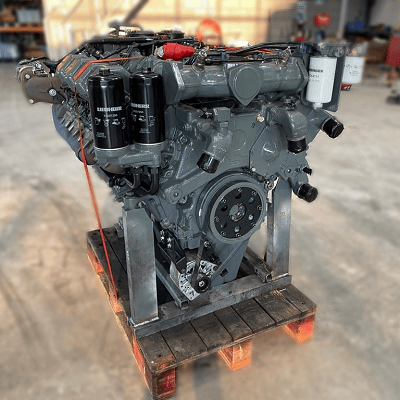The process of a dyno test on a Liebherr engine

When it comes to heavy machinery, reliability and power are paramount. Liebherr, a name synonymous with innovation and excellence in engineering, stands tall as a pioneer in the realm of heavy equipment and machinery. From towering cranes to robust excavators, Liebherr’s engineering prowess extends to the heart of these machines. We delve into the world of dyno testing a Liebherr engine, uncovering the meticulous process behind unleashing the raw power concealed within.
The foundation of excellence
Before we embark on the journey of dyno testing, it’s crucial to understand the foundation upon which Liebherr engines are built. With decades of engineering expertise and commitment to quality, Liebherr engines are crafted to withstand the most demanding environment and deliver unparalleled performance. Each component is meticulously designed and rigorously tested to ensure reliability, efficiency and longevity.
The process
1 Preparation: The engine undergoes meticulous preparation before being mounted onto the dynamo meter. This includes ensuring all connections are secure, fluids are filled to the appropriate levels, and sensors are properly calibrated.
2 Mounting: The engine is carefully mounted onto the dynamometer, a specialized device designed to simulate real-world operating conditions. Precision is paramount during this step to ensure accurate results.
3 Initial checks: Once mounted, a series of initial checks are conducted to verify proper alignment, connection integrity, and functionality of all engine systems.
4 Warm-up: The engine is started and allowed to warm up to operating temperature. This ensures consistent results and minimizes the risk of damage during testing.
5 Baseline testing: With the engine warmed up , baseline tests are conducted to establish initial performance metrics. This includes measuring power output, torque, fuel consumption, and emissions at various RPM levels.
6 Load testing: The engine is subjected to progressively increasing loads to simulate different operating conditions, such as idle, partial load and full load. This allows engineers to assess performance across the entire operating range and identify any potential issues or optimization.
7 Data analysis: Throughout the testing process, data is continuously collected and analyzed in real-time. Advanced instrumentation and software are used to monitor performance metrics and identify trends or anomalies.
8 Optimazation: Based on the data analysis, adjustments may be made to optimize engine performance. This could involve fine-tuning fuel injection timing, adjusting air-fuel ratios, or optimize turbocharger boost pressure.
9 Validation: Once testing is complete, the results are meticulously reviewed and validated against predetermined criteria and specifications. Any deviations or anomalies are thoroughly investigated to ensure accuracy and reliability.
10 Reporting: Finally, a comprehensive report is generated detailing the results of the dyno testing, including performance metrics, observations, and any recommendations for further optimization or refinement.
The outcome of dyno testing
Dyno testing a Liebherr engine is more than just a routine procedure – it’s a testament to the unwavering commitment to excellence that defines Liebherr’s engineering philosophy. By subjecting their engines to rigorous testing and analysis, Liebherr ensures that each engine delivers the uncompromising performance, reliability, and efficiency that customers expect.
In conclusion, dyno testing a Liebherr engine is not just about measuring power output. It’s about unlocking the true potential of these remarkable engines and ensuring they exceed expectations in the most challenging environments imaginable.
The Injection Machine Heater plays a pivotal role in ensuring the efficient and smooth operation of injection molding machines. It comprises various heating components that collectively contribute to maintaining optimal temperatures during the molding process.
Heating elements of an injection machine heater and their respective functions:
-
Mold Temperature Machine
- Role: This component is designed to regulate the temperature of the mold cavity, ensuring that the Plastic Material flows smoothly and uniformly. It ensures the correct cooling rate to achieve desired part quality, dimensional stability, and surface finish.
- Function: By maintaining consistent mold temperatures, it helps avoid defects like warping, sink marks, or excessive shrinkage.
-
Heating Coils
- Role: Heating coils are typically employed to provide heat to the barrel of the injection molding machine, where the plastic pellets are heated and softened.
- Function: They facilitate the melting of plastic material and its even distribution within the barrel, ensuring a consistent melt quality.
-
Nozzle Heaters
- Role: Nozzle heaters are specifically designed to keep the nozzle and injection tip at an optimal temperature, preventing premature solidification of the molten plastic.
- Function: They ensure smooth material flow from the nozzle into the mold cavity, minimizing blockages or uneven injection.
-
Hopper Dryers
- Role: Hopper dryers are used to eliminate moisture from the plastic pellets before they enter the injection molding machine.
- Function: Dry plastic pellets improve the quality of the molten material, reducing the likelihood of bubbles, voids, or discoloration in the final product.
-
Heated Platens
- Role: Heated platens are responsible for maintaining a consistent temperature in the clamping unit, where the mold halves are secured.
- Function: By keeping the clamping area warm, they ensure the even distribution of heat and minimize temperature fluctuations that can affect the molding process.
Mold Temperature Controller,Advanced Mold Heating And Control Machine,Mold Temperature Control Machine,Durable heater Temperature Control
Ningbo Outai Plastic Machinery Technology Co.,Ltd , https://www.outacmachine.com